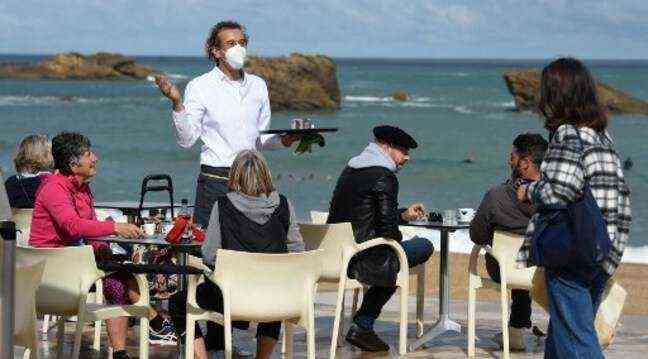The incidence rate has increased in the past week, especially in the Basque Country. – GAIZKA IROZ / AFP
- The incidence rate increased by 36% in one week in the department of Pyrénées-Atlantiques.
- The majority of infected people are under the age of 50, the most fragile people being largely vaccinated.
- There is no effect on the hospital system. Vaccination should nevertheless continue, especially among the youngest.
What is the epidemic situation in the Pyrénées Atlantiques? Government spokesman Gabriel Attala spoke on Wednesday of worrying increases in incidence rates in the South West. This is the case in several departments of Nouvelle Aquitaine, and in particular in that of Pyrénées-Atlantiques, the incidence rate is 110, which corresponds to an increase of 36% in one week.
“Something is happening all the same but it is quite normal we are deconfining, the mixing is increased and our region having been less affected during the previous waves, this young population under 50 is less immune and the virus is circulating. more among them, ”said Benoît Elleboode, Director General of ARS Nouvelle Aquitaine on Wednesday.
“The more we screen, the more patients we find”
The link with the deconfinement initiated on May 3 is obvious but the ARS specifies that there is nothing to suggest that barrier gestures are less respected in the region than elsewhere. “People get together again, there can be a bit of relaxation and as there are a lot of local festivals in this territory (of the Pyrénées-Atlantiques) this can help explain an increase in the incidence rate”, nevertheless commented Laurent Filleul, epidemiologist of Public Health France Nouvelle-Aquitaine.
Several clusters have emerged in recent weeks in the Pyrénées Atlantiques and in accordance with the protocols, many screenings have been organized. The average screening rate in France is 3,000 and it reaches 4,500 among 20-29 year olds in the Pyrénées-Atlantiques. “And the more we screen, the more patients we find”, underlines the director of the ARS. A strong disparity exists within the department of Pyrénées Atlantiques since the incidence rate in the east, in Béarn, is 83 per 100,000 and 152 per 100,000, in the Basque Country.
“Green hospital indicators”
“Our positivity rate achieved from numerous tests is 3.2 when that at the national level is 3.15, that is to say that we are in the national average”, points Jean Lacoste, assistant to the health of the city of Pau, and a doctor by profession. The hospital impact of this increase in the incidence rate is very low since currently only three people are in intensive care for Covid-19 in Bayonne and one in Pau. “All hospital indicators in the region are green,” insisted Benoit Elleboode.
Jean Lacoste recalls that throughout the epidemic, the department had the lowest incidence rates. “We must be vigilant but we are not in alarming figures”, he believes, highlighting the good figures of vaccination for those over 65 (90% of vaccination), the most exposed to the forms the most serious. “The disease is transmitted today by the youngest. The incidence rate for 18-25 year olds is 200 to 250 per 100,000, notes Jean Lacoste. It always has been, with even higher numbers. “
The prefecture of the Pyrénées-Atlantiques announced on Wednesday a strengthening of controls in the coming days “in particular in restaurants and drinking establishments, sports halls, but also on public roads to avoid wild festive gatherings and guarantee respect curfew. “We will monitor this trend in the coming weeks, with a race against time to be led with vaccination,” concludes Benoît Elleboode.

